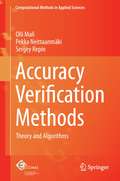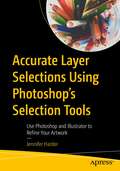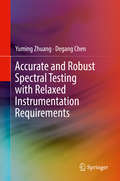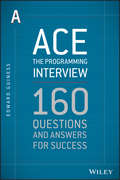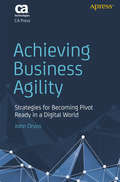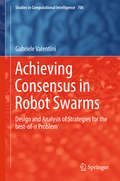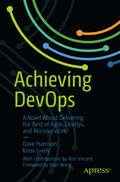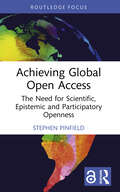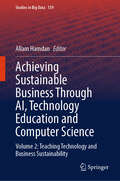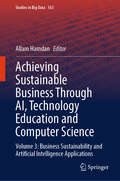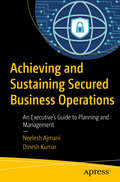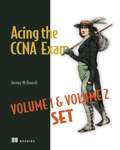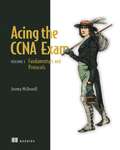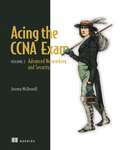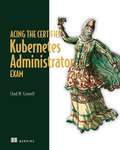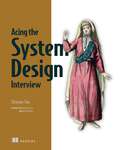- Table View
- List View
Accuracy Verification Methods: Theory and Algorithms (Computational Methods in Applied Sciences #32)
by Pekka Neittaanmäki Olli Mali Sergey RepinThe importance of accuracy verification methods was understood at the very beginning of the development of numerical analysis. Recent decades have seen a rapid growth of results related to adaptive numerical methods and a posteriori estimates. However, in this important area there often exists a noticeable gap between mathematicians creating the theory and researchers developing applied algorithms that could be used in engineering and scientific computations for guaranteed and efficient error control. The goals of the book are to (1) give a transparent explanation of the underlying mathematical theory in a style accessible not only to advanced numerical analysts but also to engineers and students; (2) present detailed step-by-step algorithms that follow from a theory; (3) discuss their advantages and drawbacks, areas of applicability, give recommendations and examples.
Accurate Layer Selections Using Photoshop’s Selection Tools: Use Photoshop and Illustrator to Refine Your Artwork
by Jennifer HarderTake your hand-drawn illustrations to the next level by using various selection tools in Photoshop to clean up the artwork, and Illustrator for final refinement. Also, learn to save your artwork as vector images to be used for web, print, or even stills for character animation. Author Jennifer Harder begins by showing you how to use basic tools in Photoshop to clean up your artwork, followed by Marquee tools and more. Next, you will see how to use more advanced tools such as Lasso, Magic Wand, the Object Selection tool, and so on. You’ll then get a demonstration of how to control the type of selection using the selection main menu, how to copy selections to another layer, and how to use the focus area. This is followed by a chapter that covers paths, channels, and layer masks that you will master to clean up your artwork. To round things out, you will learn how to use Illustrator’s different features to further enhance your work. On completing the book, you will have mastered how to make your artwork and illustrations portfolio-ready. What You Will LearnMaster each selection tool found in PhotoshopChoose the right tools for cleaning and refining artworkSave selections for other projectsMake your artwork scalable in Illustrator using various methods Who Is This Book For Readers with little-to-intermediate-level experience with Photoshop.
Accurate and Robust Spectral Testing with Relaxed Instrumentation Requirements
by Yuming Zhuang Degang ChenThis book introduces a family of new methods for accurate and robust spectral testing and fills an information gap, as the requirements in standard test have grown increasingly challenging in recent high precision testing, especially as the device performance has continued to improve. Test engineers will be enabled to accurately set their devices & systems at much simpler test setup, much reduced complexity and much lower cost.
Ace the Programming Interview
by Edward GuinessBe prepared to answer the most relevant interview questions and land the job Programmers are in demand, but to land the job, you must demonstrate knowledge of those things expected by today's employers. This guide sets you up for success. Not only does it provide 160 of the most commonly asked interview questions and model answers, but it also offers insight into the context and motivation of hiring managers in today's marketplace. Written by a veteran hiring manager, this book is a comprehensive guide for experienced and first-time programmers alike. Provides insight into what drives the recruitment process and how hiring managers think Covers both practical knowledge and recommendations for handling the interview process Features 160 actual interview questions, including some related to code samples that are available for download on a companion website Includes information on landing an interview, preparing a cheat-sheet for a phone interview, how to demonstrate your programming wisdom, and more Ace the Programming Interview, like the earlier Wiley bestseller Programming Interviews Exposed, helps you approach the job interview with the confidence that comes from being prepared.
Achievement Relocked: Loss Aversion and Game Design (Playful Thinking)
by Geoffrey EngelsteinHow game designers can use the psychological phenomenon of loss aversion to shape player experience.Getting something makes you feel good, and losing something makes you feel bad. But losing something makes you feel worse than getting the same thing makes you feel good. So finding $10 is a thrill; losing $10 is a tragedy. On an “intensity of feeling” scale, loss is more intense than gain. This is the core psychological concept of loss aversion, and in this book game creator Geoffrey Engelstein explains, with examples from both tabletop and video games, how it can be a tool in game design. Loss aversion is a profound aspect of human psychology, and directly relevant to game design; it is a tool the game designer can use to elicit particular emotions in players. Engelstein connects the psychology of loss aversion to a range of phenomena related to games, exploring, for example, the endowment effect—why, when an object is ours, it gains value over an equivalent object that is not ours—as seen in the Weighted Companion Cube in the game Portal; the framing of gains and losses to manipulate player emotions; Deal or No Deal's use of the utility theory; and regret and competence as motivations, seen in the context of legacy games. Finally, Engelstein examines the approach to Loss Aversion in three games by Uwe Rosenberg, charting the designer's increasing mastery.
Achieving Business Agility: Strategies for Becoming Pivot Ready in a Digital World
by John OrvosKnow how to lead and establish business agility in your organization. Benefit from clear, actionable steps based on change management truths that have been long underutilized and have limited the success of agile expansion into your business. This book provides a pragmatic framework for leading your business toward shifting to an agile mindset. Achieving Business Agility offers strategies and concrete examples to engage business executives and will teach you how to effectively execute these strategies. Whether you are a delivery executive, a change advocate, a consultant, a business leader, or a newcomer to agile, you will learn clear actions from a practical, business-oriented perspective that is vital to effect change and bring agile into your business. The book is structured in three sections. The first provides you with a deep understanding of each of four strategies. The second section tells the story of a company that applied these strategies through the eyes of several key players. The last section helps you get started applying what you learned in your own company. What You’ll Learn Get the attention of your executives by alerting them to a company problem that can impact them personally and create a sense of urgency to address itCollaborate with your executives in a way that gets them to open up and to see how their operating model is a contributing cause to the company problemDemonstrate how your executives can specifically benefit from a new agile business operating model and address the company problemCreate a reinforcement structure on a larger scale to establish agile as the new standard operating model in your organization Who This Book Is For Managers, business leaders, and consultants at/for large enterprises or small startups who want their company to better compete in today’s fast-moving markets that present threats and opportunities at every turn. No agile expertise is required.
Achieving Business Competitiveness in a Digital Environment: Opportunities in E-commerce and Online Marketing (Contributions to Management Science)
by Tereza Semerádová Petr WeinlichThe COVID-19 pandemic has been a very strong reminder that the future economic development of any country is more than ever influenced by its ability to ramp-up digital competitiveness. Consequently, enterprises were pushed to assess and develop the possibilities offered by e-commerce and online marketing tools. In this book, experts outline the prerequisites for such online marketing competitiveness and compare the current level of digital marketing competitiveness in Europe by using publicly available macro and micro-level data. The authors present their analyses and recommendations including interviews with over 125 online marketers and e-commerce specialists and present the lessons from digitalization of over 600 SMEs.
Achieving Consensus in Robot Swarms: Design and Analysis of Strategies for the best-of-n Problem (Studies in Computational Intelligence #706)
by Gabriele ValentiniThis book focuses on the design and analysis of collective decision-making strategies for the best-of-n problem. After providing a formalization of the structure of the best-of-n problem supported by a comprehensive survey of the swarm robotics literature, it introduces the functioning of a collective decision-making strategy and identifies a set of mechanisms that are essential for a strategy to solve the best-of-n problem. The best-of-n problem is an abstraction that captures the frequent requirement of a robot swarm to choose one option from of a finite set when optimizing benefits and costs. The book leverages the identification of these mechanisms to develop a modular and model-driven methodology to design collective decision-making strategies and to analyze their performance at different level of abstractions. Lastly, the author provides a series of case studies in which the proposed methodology is used to design different strategies, using robot experiments to show how the designed strategies can be ported to different application scenarios.
Achieving DevOps: A Novel About Delivering the Best of Agile, DevOps, and Microservices
by Dave Harrison Knox LivelyBen is stuck. A development lead with a strong vision for how the intersection of development and operations at his office can be improved, he can’t help but feel overwhelmed and discouraged by common problems such as slow turnaround time, rushed and ineffective handover documentation, mounting technical debt, and a lagging QA process. What steps should Ben take to build the momentum needed to create positive changes within his company? In this unique business novel by Dave Harrison and Knox Lively, two DevOps professionals with years of diverse experience in the industry, you follow Ben as he solves work frustrations in order to adopt Agile, DevOps, and microservices architectures for his organization. Achieving DevOps addresses the “Now what?” moment many DevOps professionals face on their journey. The story provides you with the knowledge you need to navigate the internal political waters, build management support, show measurable results, and bring DevOps successfully into your organization.Come away with practical lessons and timeless business concepts. You’ll know how to effect change in a company from the bottom up, gain support, and instill a pattern of progressively building on success. Experience Ben’s progress vicariously in Achieving DevOps and bridge the gap between inspiration and the implementation of your own DevOps practices.Who This Book Is ForThose serving as change agents who are working to influence and move their organizations toward a DevOps approach to software development and deployment: those working to effect change from the bottom up such as development leads, QA leads, project managers, and individual developers; and IT directors, CTOs, and others at the top of an organization who are being asked to lend their support toward DevOps implementation efforts
Achieving Global Open Access: The Need for Scientific, Epistemic and Participatory Openness (Routledge Critical Studies on Open Access)
by Stephen PinfieldAchieving Global Open Access explores some of the key conditions that are necessary to deliver global Open Access (OA) that is effective and equitable.Often assumed to be a self-evident good, OA has been subject to growing criticism for perpetuating global inequities and epistemic injustices. It has been seen as imposing exploitative business and publishing models and as exacerbating exclusionary research evaluation cultures and practices. Pinfield engages with these issues, recognising that the global OA debate is now not just about publishing business models and academic reward structures, but also about what constitutes valid and valuable knowledge, how we know, and who gets to say. The book argues that, for OA to deliver its potential, it first needs to be associated with ‘epistemic openness’, a wider and more inclusive understanding of what constitutes valid and valuable knowledge. It also needs to be accompanied by ‘participatory openness’, enabling contributions to knowledge from more diverse communities. Interacting with relevant theory and current practice, the book discusses the challenges in implementing these different forms of openness, the relationships between them, and their limits.Achieving Global Open Access is essential reading for academics and students engaged in the study of Library and Information Science, Open Access and Publishing. It will also be valuable and interesting to library and publishing professionals around the world.
Achieving Service-Oriented Architecture
by Rick SweeneyA complete, comprehensive methodology and framework for adopting and managing a successful service oriented architecture environment Achieving Service-Oriented Architecture helps to set up an SOA Architecture Practice defining the policies, procedures, and standards that apply not just to IT developers but to the entire corporation as it relates to business applications. Why a new architectural approach is necessary for your business to achieve all the value SOA has to offer Focuses on setting up an enterprise architecture practice for service-oriented architecture Discusses the implementation and governance processes for SOA Defines and describes an overall architectural framework for managing SOA assets at an enterprise architecture level Shows how to set up and run an SOA Enterprise Architecture Practice using the methodology and framework presented Defining how an Architecture Practice can transform itself and your corporation to maximize the benefits of the SOA approach, Achieving Service-Oriented Architecture provides a pragmatic enterprise architecture approach and framework for implementing and managing service oriented architecture from a business organization and business practices perspective. Note: CD-ROM/DVD and other supplementary materials are not included as part of eBook file.
Achieving Supply Chain Agility: Information System Integration in the Chinese Automotive Industry
by Yi WuThis book identifies factors of information system (IS) integration that influence supply chain agility and illustrates how IS integration can achieve greater supply chain agility. Also considering the consequent operational impacts that arise from IS-enabled supply chain agility, the author presents real-life examples through interviews and surveys to explore how IS integrations affect supply chain agility in the context of the Chinese automotive industry. The ability to swiftly respond to competitive challenges is a key element in industry 4.0 and organisations with agile supply chains are better prepared to respond to uncertainties and changes. This book develops and presents guidelines on the deployment of information system integration in order to achieve efficient agile supply chains.
Achieving Sustainable Business Through AI, Technology Education and Computer Science: Volume 2: Teaching Technology and Business Sustainability (Studies in Big Data #159)
by Allam HamdanThis book delves into the relationship between artificial intelligence, technology education, and computer science intersect with sustainable business practices. This book discovers the transformative potential of cutting-edge technologies like artificial intelligence, machine learning, and blockchain across diverse sectors such as health care, education, government services, and digital transformation.
Achieving Sustainable Business Through AI, Technology Education and Computer Science: Volume 3: Business Sustainability and Artificial Intelligence Applications (Studies in Big Data #163)
by Allam HamdanThis book focuses on the symbiotic relationship between sustainable practices and cutting-edge AI technologies, offering insights into how businesses can thrive in a rapidly evolving landscape. This book discovers how AI is revolutionizing sustainability efforts, driving efficiency, and fostering a greener tomorrow. From smart energy management to ethical supply chain practices, this book is a guide for organizations looking to harness the power of AI for a sustainable future. Engaging, informative, and forward-thinking, this book is essential reading for leaders shaping the future of business.
Achieving Sustainable Business through AI, Technology Education and Computer Science: Volume 1: Computer Science, Business Sustainability, and Competitive Advantage (Studies in Big Data #158)
by Allam HamdanThis book aims to explore the intersection of AI, technology education, and computer science with sustainable business practices. It delves into the application of cutting-edge technologies such as artificial intelligence, machine learning, and blockchain in various business domains, including healthcare, education, government services, and digital transformation.
Achieving Your Potential As A Photographer: A Creative Companion and Workbook
by Harold DavisComing from the perspective that true inspiration and great image making are at the core of any high-level photographic endeavour, Achieving Your Potential as a Digital Photographer presents an organized and cohesive plan for kickstarting creativity, and then taking the resulting work into the real world. The ideas presented have been formulated by Harold Davis over many years working as a creative artist and award-wining photographer, and in the celebrated workshops he has developed and led all around the world. These concepts are presented with accompanying exercises so that readers can put them into everyday practice as well as workbook pages bound into the book for note taking and journaling. This book will enrich your photographic practice whether the goal is simply to enrich your photography or to make money from your work.
Achieving and Sustaining Secured Business Operations: An Executive’s Guide to Planning and Management
by Dinesh Kumar Neelesh AjmaniProactively plan and manage innovation in your business while keeping operations safe and secure. This book provides a framework and practices to help you safeguard customer information, prevent unauthorized access, and protect your brand and assets. Securing company operations is a board-level discussion. Across all industries, companies are pouring millions of dollars into taming cybercrime and other related security crime. Achieving and Sustaining Secured Business Operations presents a holistic approach looking top down, bottom up, and sideways. The end goal is to achieve and sustain a safe environment to conduct secured business operations while continuously innovating for competitive advantage. What You'll Learn Discover why security, specifically secured business operations, needs to be part of business planning and oversight by design and not left to technologists to make the business case Determine what you can do in your role and in your organization to drive and implement integration and improvements in planning and managing secured business operations in conjunction with other business planning and management activities Choose ways in which progress toward achieving and sustaining secured business operations can be measured Understand best practices for organizing, planning, architecting, governing, monitoring, and managing secured business operations Create a framework, including methods and tools for operationalizing assessment, planning, and ongoing management of secured business operations Use cases and potential case studies for various industries and business models Who This Book Is For Chief executive officers and their leadership team; chief operations officers; chief information officers and their leadership team; chief information security officers; business functional middle managers; and enterprise, solution, and information technology architects
Acing Online Assessment: Your Guide to Success (Student Success)
by Lucinda Becker Felicity Becker Anastasia BeckerFacing an online assessment? Here’s how to ace it. This straightforward guide helps you translate your existing skills into an online environment. It enables you to transition from understanding familiar, offline assessments to succeeding in formal online assessments by breaking down what you are being asked to do - then shows you how to prepare, where to get help and what to do on the day. From presentations to portfolios, it demonstrates that, once you understand this new way of being assessed, you can make the most of working online to improve your grades and excel in your work. It also: Equips you with strategies to help manage anxieties around online assessment. Highlights the challenges and benefits that are unique to online assessment. Demonstrates how to make the most of feedback to support your development as a self-reflective learner. With each chapter built around key student questions, this guide is perfect for dipping into for any type of online assessment. Student Success is a series of essential guides for students of all levels. From how to think critically and write great essays to boosting your employability and managing your wellbeing, the Student Success series helps you study smarter and get the best from your time at university.
Acing Online Assessment: Your Guide to Success (Student Success)
by Lucinda Becker Felicity Becker Anastasia BeckerFacing an online assessment? Here’s how to ace it. This straightforward guide helps you translate your existing skills into an online environment. It enables you to transition from understanding familiar, offline assessments to succeeding in formal online assessments by breaking down what you are being asked to do - then shows you how to prepare, where to get help and what to do on the day. From presentations to portfolios, it demonstrates that, once you understand this new way of being assessed, you can make the most of working online to improve your grades and excel in your work. It also: Equips you with strategies to help manage anxieties around online assessment. Highlights the challenges and benefits that are unique to online assessment. Demonstrates how to make the most of feedback to support your development as a self-reflective learner. With each chapter built around key student questions, this guide is perfect for dipping into for any type of online assessment. Student Success is a series of essential guides for students of all levels. From how to think critically and write great essays to boosting your employability and managing your wellbeing, the Student Success series helps you study smarter and get the best from your time at university.
Acing the CCNA Exam Volumes 1 & 2
by Jeremy McDowellPass the Cisco Certified Network Associate (CCNA) exam on your very first try!
Acing the CCNA Exam, Volume 1: Fundamentals and Protocols
by Jeremy McDowellMaster the core fundamentals and protocols covered in the Cisco Certified Network Associate (CCNA) exam!Acing the CCNA Exam helps you prepare for the CCNA exam by learning vital skills like: How to study for the CCNA IP routing, addressing, and subnetting VLANs, trunking protocols, and EtherChannel Static and dynamic routing protocols (OSPF) Passing the CCNA is the perfect way to kickstart or advance your career in IT, networking, and systems administration. Inside this accessible guide, you&’ll find the secrets to nailing even the most perplexing exam topics. You&’ll build your fluency in networking chapter-by-chapter, until you have both the knowledge to take on the CCNA, and the skills to work effectively as an IT professional. About the technology The Cisco Certified Network Associate (CCNA) certification is the gold-standard credential for aspiring network administrators working with industry-standard Cisco hardware. There&’s a lot to learn, and this book is your expert guide. Acing the CCNA Exam, Volume 1 introduces the foundations of Cisco networking technology, including the core protocols for IP routing, addressing, trunking, and more. About the book Acing the CCNA Exam, Volume 1 teaches you the technical skills you need, along with must-know test secrets, to ace the CCNA the very first time. You&’ll love networking guru Jeremy McDowell&’s down-to-earth writing and handy network diagrams as he leads you through the most challenging parts of the exam. In this first volume, you&’ll master ports and routers, IP access control lists, and other core topics you&’ll face in the first part of the certification. What's inside How to study for the CCNA IP routing, addressing, and subnetting VLANs, trunking protocols, and EtherChannel Static and dynamic routing protocols (OSPF) About the reader No networking skills required! About the author Jeremy McDowell is a senior network engineer and an experienced teacher. His YouTube channel, Jeremy&’s IT Lab, has helped hundreds of thousands prepare for the CCNA. The technical editor on this book was Jeremy Cioara. Table of Contents 1 Introduction to the CCNA Part 1 2 Network devices 3 Cables, connectors, and ports 4 The TCP/IP networking model 5 The Cisco IOS CLI 6 Ethernet LAN switching 7 IPv4 addressing 8 Router and switch interfaces Part 2 9 Routing fundamentals 10 The life of a packet 157 11 Subnetting IPv4 networks Part 3 12 VLANs 13 Dynamic Trunking Protocol and VLAN Trunking Protocol 14 Spanning Tree Protocol 15 Rapid Spanning Tree Protocol 16 EtherChannel Part 4 17 Dynamic routing 18 Open Shortest Path First 19 First hop redundancy protocols Part 5 20 IPv6 addressing 21 IPv6 routing Part 6 22 Transmission Control Protocol and User Datagram Protocol 23 Standard access control lists 24 Extended access control lists A Exam topics reference table B CLI command reference table C Chapter quiz questions D Chapter quiz answers
Acing the CCNA Exam, Volume 2: Advanced Networking and Security
by Jeremy McDowellMaster the most challenging elements of the CCNA exam to pass on your very first try!The CCNA goes deep on networking and security. Acing the CCNA Exam, Volume 2 gives you exactly what you need to navigate the most challenging parts of the exam. Author Jeremy McDowell&’s CCNA courses have helped hundreds of thousands of students pass their exams. This book distills that expertise into an easy-to-follow guide. In Acing the CCNA Exam, Volume 2—Advanced Networking and Security you&’ll dig into tough topics like: • Security concepts and common threats • Ethernet and wireless LANs (Wi-Fi) and network automation • Essential network services like DHCP and DNS • WAN, LAN, and wireless architectures The Cisco Certified Network Associate is the gold-standard credential for network administrators. It demands an in-depth knowledge of complex network internals, including security, wireless architectures, and more. Acing the CCNA Exam, Volume 2—Advanced Networking and Security builds on the basics you learn in Volume 1 to help you study and prepare for the most challenging parts of the test. About the Technology The Cisco Certified Network Associate (CCNA) certification is the gold-standard credential for aspiring network administrators working with industry-standard Cisco hardware. The CCNA exam goes deep, and this book will help you prepare for the most difficult parts of the test. Acing the CCNA Exam, Volume 2 covers the demanding topics of network security, wired and wireless LANs, DNS, and more. About the Book Acing the CCNA Exam, Volume 2 introduces the technical skills and secrets you need to navigate the most challenging topics on the CCNA exam. CCNA expert Jeremy McDowell guides you through network services and architectures, automation, and other advanced topics you&’ll face in the later parts of the test. His down-to-earth writing, diagrams, and clear examples make even the most complex topics easy to understand. What&’s Inside • Security concepts and common threats • Ethernet and wireless LANs (Wi-Fi) and network automation • Essential network services like DHCP and DNS • WAN, LAN, and wireless architectures About the Readers This book builds on Acing the CCNA Exam, Volume 1. About the Author Jeremy McDowell is a senior network engineer and an experienced teacher. His YouTube channel, Jeremy&’s IT Lab, has helped hundreds of thousands prepare for the CCNA. The technical editor on this book was Jeremy Cioara. Table of Contents Part 1 1 Cisco Discovery Protocol and Link Layer Discovery Protocol 2 Network Time Protocol 3 Domain Name System 4 Dynamic Host Configuration Protocol 5 Secure Shell 6 Simple Network Management Protocol 7 Syslog 8 Trivial File Transfer Protocol and File Transfer Protocol 9 Network Address Translation 10 Quality of service Part 2 11 Security concepts 12 Port Security 13 DHCP Snooping 14 Dynamic ARP Inspection Part 3 15 LAN architectures 16 WAN architectures 17 Virtualization and cloud Part 4 18 Wireless LAN fundamentals 19 Wireless LAN architectures 20 Wireless LAN security 21 Wireless LAN configuration Part 5 22 Network automation 23 REST APIs 24 Data formats 25 Ansible and Terraform A Exam topics reference table B CLI command reference table C Chapter quiz questions D Chapter quiz answers
Acing the Certified Kubernetes Administrator Exam
by Chad CrowellBecoming a Kubernetes administrator is a big accomplishment—and passing the Certified Kubernetes Administrator (CKA) exam can be a big boost to your career! Learn the hands on skills you need to ace the exam with clear teaching and hands-on exercises that match the unique CKA test environment.In Acing the Certified Kubernetes Administrator Exam you&’ll learn how to: Administer an application running on Kubernetes Troubleshoot errors inside a Kubernetes cluster Authenticate users and machines to the Kubernetes API Create persistent storage in Kubernetes Add additional functionality to an existing Kubernetes cluster Acing the Certified Kubernetes Administrator Exam is your fast-track to becoming a Certified Kubernetes Administrator! Your expert exam tutor is Chad Crowell, whose courses have helped thousands of developers to understand Kubernetes and earn the coveted CKA certification. If you&’re familiar with Kubernetes, this book will ensure you&’re ready to pass in just one month of study. If you&’re brand new, this is the perfect primer to get started on your Kubernetes journey. Go hands-on with all the exam objectives, including deploying containerized applications to Kubernetes, accessing an application from an ingress resource, and backup and restore. Plus, essential exam tips and exercises help you work out your mental muscle memory. About the technology The Certified Kubernetes Administrator (CKA) exam proves to your next employer that you can set up and manage Kubernetes clusters. In this rigorous test offered by the Linux Foundation, you&’ll configure and manage production-grade clusters hands-on as a proctor watches. Simply put, if you aren&’t ready, you won&’t pass. About the book Acing the Certified Kubernetes Administrator Exam teaches every skill you need to pass the CKA. You can&’t &“hack&” this exam by learning a few test-taking tricks. Instead, you&’ll master vital techniques like load balancing and networking with carefully designed exercises that you practice using the CKA&’s command-line interface. With this book, you&’ll be confident and ready for exam day. What's inside Administer an application on Kubernetes Troubleshoot errors in a Kubernetes cluster Authenticate users and machines Create persistent storage About the reader For readers who know the basics of containers and Linux admin. No Kubernetes experience required. About the author Chad M. Crowell is the author of dozens of courses on Kubernetes and DevOps with Pluralsight and INE. Chad is also a Microsoft Certified Trainer (MCT). Table of Contents 1 First steps 2 Kubernetes cluster 3 Identity and access management 4 Deploying applications in Kubernetes 5 Running applications in Kubernetes 6 Communication in a Kubernetes cluster 7 Storage in Kubernetes 8 Troubleshooting Kubernetes 9 Taking the test
Acing the System Design Interview
by Zhiyong TanThe system design interview is one of the hardest challenges you&’ll face in the software engineering hiring process. This practical book gives you the insights, the skills, and the hands-on practice you need to ace the toughest system design interview questions and land the job and salary you want.In Acing the System Design Interview you will master a structured and organized approach to present system design ideas like: Scaling applications to support heavy traffic Distributed transactions techniques to ensure data consistency Services for functional partitioning such as API gateway and service mesh Common API paradigms including REST, RPC, and GraphQL Caching strategies, including their tradeoffs Logging, monitoring, and alerting concepts that are critical in any system design Communication skills that demonstrate your engineering maturity Don&’t be daunted by the complex, open-ended nature of system design interviews! In this in-depth guide, author Zhiyong Tan shares what he&’s learned on both sides of the interview table. You&’ll dive deep into the common technical topics that arise during interviews and learn how to apply them to mentally perfect different kinds of systems. Foreword by Anthony Asta, Michael D. Elder. About the technology The system design interview is daunting even for seasoned software engineers. Fortunately, with a little careful prep work you can turn those open-ended questions and whiteboard sessions into your competitive advantage! In this powerful book, Zhiyong Tan reveals practical interview techniques and insights about system design that have earned developers job offers from Amazon, Apple, ByteDance, PayPal, and Uber. About the book Acing the System Design Interview is a masterclass in how to confidently nail your next interview. Following these easy-to-remember techniques, you&’ll learn to quickly assess a question, identify an advantageous approach, and then communicate your ideas clearly to an interviewer. As you work through this book, you&’ll gain not only the skills to successfully interview, but also to do the actual work of great system design. What's inside Insights on scaling, transactions, logging, and more Practice questions for core system design concepts How to demonstrate your engineering maturity Great questions to ask your interviewer About the reader For software engineers, software architects, and engineering managers looking to advance their careers. About the author Zhiyong Tan is a manager at PayPal. He has worked at Uber, Teradata, and at small startups. Over the years, he has been in many system design interviews, on both sides of the table. The technical editor on this book was Mohit Kumar. Table of Contents PART 1 1 A walkthrough of system design concepts 2 A typical system design interview flow 3 Non-functional requirements 4 Scaling databases 5 Distributed transactions 6 Common services for functional partitioning PART 2 7 Design Craigslist 8 Design a rate-limiting service 9 Design a notification/alerting service 10 Design a database batch auditing service 11 Autocomplete/typeahead 12 Design Flickr 13 Design a Content Distribution Network (CDN) 14 Design a text messaging app 15 Design Airbnb 16 Design a news feed 17 Design a dashboard of top 10 products on Amazon by sales volume Appendix A Monoliths vs. microservices Appendix B OAuth 2.0 authorization and OpenID Connect authentication Appendix C C4 Model Appendix D Two-phase commit (2PC)
Acoso Textual
by Raúl Vallejo¿Una? ¿Un? estudiante universitario explora su identidad inventando múltiples personalidades virtuales e intercambiando correos electrónicos con curiosos personajes, virtuales ellos también, alrededor del mundo. Así, banano@wam.umd.edu en ocasiones se presenta como un romántico en busca del amor, en otras es una posgraduada de ciencias políticas que problematiza las utopías socialistas del siglo xx, o se convierte en un explorador del placer del sexo virtual. Para cada uno de sus interlocutores cibernéticos tiene un género, un interés y una personalidad distintos. Es un ser andrógino como el lenguaje. Ahora, banano@wam.umd.edu debe enfrentarse a sus propias preguntas: ¿Debo matar a las personalidades ficticias para encontrar mi identidad verdadera? ¿Debería convertir mis relaciones virtuales en realidades físicas? ¿Qué valor tiene la palabra virtual? Acoso textual, novela pionera en la literatura hispanoamericana en el uso de correos electrónicos para relaciones epistolares, nos ubica en un espacio virtual en que las personas se construyen a sí mismas con las palabras que van y vienen a través de Internet.
